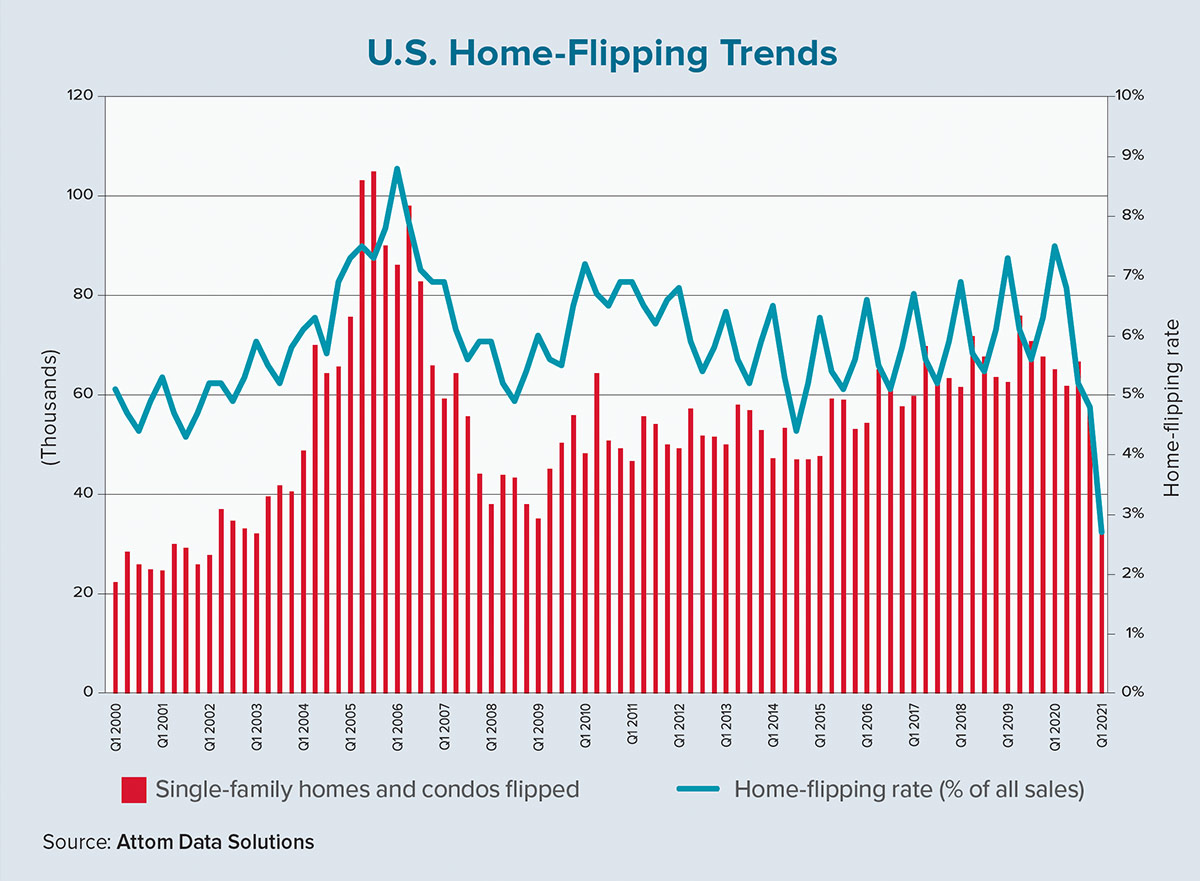In first-quarter 2021, only 32,526 single- family homes and condominiums were flipped in the U.S. This figure equated to only 2.7% of all home sales, according to Attom Data Solutions’ Q1 2021 U.S. Home Flipping Report.
This marked the lowest share of flips since 2000, and it was accompanied by significant decreases in quarterly and yearly growth. In Q1 2020, 7.5% of all sales were flips. In Q4 2020, this share stood at 4.8%. The recent declines also marked the largest pullbacks in quarterly and yearly flipping rates since at least 2000.
Simultaneously, the gross profit on a typical home flip declined across the nation. The typical flip resulted in a profit of $71,000 in Q4 2020, but this figure dipped to $63,500 in the ensuing three months. Although the gross profit remained higher on a year-over-year basis, a concerning trend developed as profit margins also declined in first-quarter 2021.
The typical gross flipping profit of $63,500 in Q1 2021 translated to a 37.8% return on investment (ROI), down significantly from 41.8% in the prior quarter and down slightly from 38.8% one year earlier. This ROI figure was the lowest since second-quarter 2011, when the housing market was still reeling from the effects of the Great Recession.
Despite the ongoing trend of rising U.S. home-sales prices, the median price of flipped homes in the first quarter of this year was $231,500, down 3.9% from the previous quarter. This was the largest quarterly decline since first-quarter 2011 and the first quarterly decrease since fourth-quarter 2018. Year over year, however, the typical resale price grew from $220,000.
These downward trends are noteworthy during a time that is otherwise characterized as a housing boom. With mortgage rates dipping below 3%, prospective homebuyers swarmed the market last year. The COVID-19 pandemic pushed people to seek more space for work-from-home scenarios and to alleviate the close confines of urban living. These buyers entered an already tight market and caused median home values to increase by more than 10% across much of the U.S. in 2020.
Although this created a seller’s market, the rapid increase in home prices didn’t necessarily benefit investors. Home flippers typically need at least six months to renovate and resell homes. Prices may flatten during this period and shrink ROI considerably. As the market enters its 10th year of price increases, there are concerns that it may be reaching its apex, causing some investors to be wary.
Only time will tell where the market will go, but these trends bear close watching. This is particularly true in local markets, which may buck national trends. Home flips as a portion of all sales declined from Q4 2020 to Q1 2021 in 76 of the 108 metropolitan statistical areas tracked by Attom Data. Memphis led the nation with an 80% decline in its home-flipping rate, followed by Lakeland, Florida (down 75%); San Francisco (down 74%); Columbia, South Carolina (down 73%); and Palm Bay, Florida (down 73%).
At the other end of the spectrum, the home-flipping rate in Springfield, Massachusetts, jumped by 114% during the same time frame. Other metros with sizable increases included Albuquerque, New Mexico (up 103%); Springfield, Illinois (up 95%); South Bend, Indiana (up 86%); and Boston (up 79%).
Location also significantly factored into profits, with the highest gross profits in Q1 2021 concentrated in the West, Northeast and South regions. Each of the top 20 metros for highest profits were in these regions, led by New York City (gross profit of $166,375); Pittsburgh ($152,041); Los Angeles ($145,000); San Francisco ($139,250); and San Diego ($136,000).
As the housing boom continues, it will be important to watch home-flipping numbers and measure the marketwide effects of continued home-price increases and high demand. Although home-flipping rates and ROI figures have been declining on a nationwide basis, localized pockets have bucked these trends and may bear fruit for shrewd investors. ●
Author
-

Todd Teta is chief product and technology officer at Attom Data Solutions, where he leads the company’s technology and product teams. Prior to joining Attom Data Solutions, Teta led the product-development and technology organization at Meyers Research. Teta also previously co-founded several startups, including VisionCore, a company serving the mortgage and real estate data and analytics markets that was later sold to CoreLogic. He is a graduate of the University of Southern California, where he earned a degree in computer engineering and computer science. Learn more about Attom Data Solutions at attomdata.com.
View all posts







